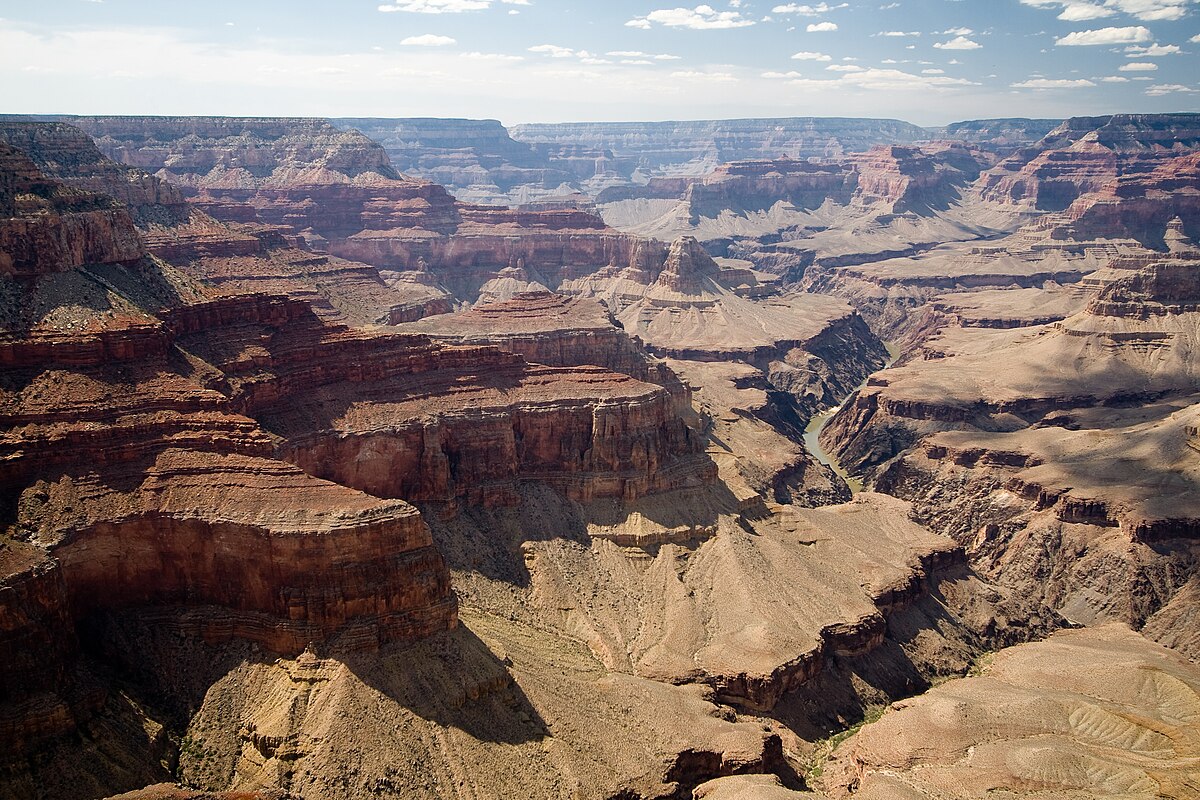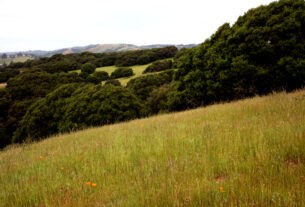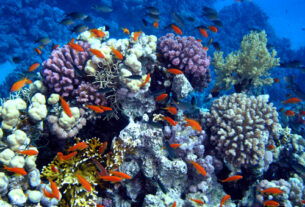Natural Wonders of The World
Nature has sculpted the Earth into stunning landscapes and phenomena that captivate our imaginations and remind us of the planet’s incredible beauty and power. From towering mountains to vibrant coral reefs, here are ten natural wonders that showcase the diversity and splendor of our world:
1. Grand Canyon, USA
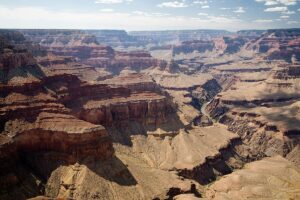
(commons.wikipedia)
The Grand Canyon in Arizona, carved by the Colorado River over millions of years, is a testament to erosion’s unrelenting forces. Its huge scale and bright rock formations attract millions of visitors each year, spanning over 277 miles (446 kilometers) and plummeting more than a mile (1.6 kilometers).
The canyon formed roughly 6 million years ago, displaying a geological history of almost 2 billion years through its strata of sedimentary rock. Its complex color palette, ranging from deep reds to gentle yellows, dazzles at sunrise and dusk, emphasizing the rocky landscape.
Beyond its geological significance, the Grand Canyon is culturally significant to Native American groups such as the Havasupai and Navajo. The South Rim is open year-round and includes overlooks, hiking paths, and visitor centers where visitors may learn about the geology and fauna.
2. Great Barrier Reef, Australia

(commons.wikipedia)
The Great Barrier Reef, located off the coast of Queensland, is the world’s biggest coral reef system and a UNESCO World Heritage site with significant biological value. It covers 2,300 kilometers (1,430 miles) and is home to approximately 1,500 fish species, 400 coral kinds, and a rich array of marine life, including sea turtles and dolphins. Its vivid corals in blues, greens, and oranges provide a fantastic backdrop for divers and snorkelers.
Marine protected zones and sustainable tourism practices are being used to offset concerns including climate change and coral bleaching. Popular entry points to this natural wonder include Cairns and the Whitsunday Islands, which are valued for their ecological richness and cultural significance to Indigenous Australian communities.
Preserving the Great Barrier Reef ensures that future generations can marvel at its beauty and understand its significance as a global treasure of marine biodiversity and natural heritage.
3. Northern Lights (Aurora Borealis)
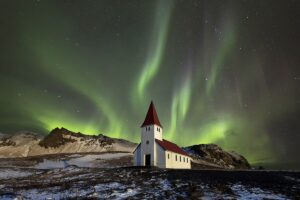
(commons.wikipedia)
The Northern Lights, also known as the Aurora Borealis, are a stunning natural light display that illuminates the Arctic skies with shimmering curtains of green, red, and purple hues. This celestial phenomenon occurs when charged particles from the sun collide with gases in the Earth’s atmosphere, most notably oxygen and nitrogen.
The most common type of aurora is green, which occurs when solar particles excite oxygen molecules approximately 60 miles above the Earth’s surface. Red auroras are caused by oxygen molecules at higher altitudes, with occasional purple or violet tints emerging during periods of extreme solar activity.
High-latitude regions such as Scandinavia, Canada, Alaska, and Iceland provide excellent viewing opportunities, especially during solar storms. Clear, dark skies free of urban light pollution improve visibility of this celestial event.
4. Mount Everest, Nepal/Tibet
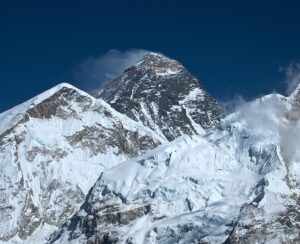
(commons.wikipedia)
Mount Everest, at 8,848 meters (29,029 feet), is the world’s tallest peak, located in the Himalayas on the Nepal-Tibet border. Its majestic presence and arduous ascent draw adventurers and mountaineers from all over the world.
Everest’s summit, nicknamed as “the roof of the world,” was formed millions of years ago by tectonic processes and has long been considered the pinnacle of mountaineering achievement. In 1953, Sir Edmund Hillary and Tenzing Norgay became the first confirmed climbers to reach the summit, establishing a tradition of exploration and tenacity.
Despite its allure, Everest faces environmental challenges such as melting glaciers and waste from expeditions. Conservation efforts aim to promote sustainable climbing practices and preserve its fragile ecosystem. For the Sherpa people, Everest holds deep cultural and spiritual significance, with Sherpas playing vital roles in guiding and supporting climbers.
5. Victoria Falls, Zambia/Zimbabwe

(commons.wikipedia)
One of the world’s largest waterfalls, Victoria Falls, is located on the Zambezi River between Zambia and Zimbabwe. It is 1,708 meters (5,604 feet) broad and descends 108 meters (354 feet), resulting in the deafening cascade known as “Mosi-oa-Tunya” (the Smoke that Thunders).
Visitors can explore viewpoints in Victoria Falls National Park (Zimbabwe) and Mosi-oa-Tunya National Park (Zambia) for panoramic views of its roaring waters and misty spray. Activities include guided tours, river cruises, and adrenaline-pumping experiences like bungee jumping and white-water rafting on the Zambezi.
Victoria Falls holds cultural and ecological significance, supporting a diverse rainforest ecosystem with wildlife such as vervet monkeys and colorful bird species. Conservation efforts prioritize sustainable tourism and environmental protection to preserve this natural wonder for future generations to enjoy its grandeur and cultural importance.
6. Parícutin Volcano, Mexico

(commons.wikipedia)
Parícutin is a cinder cone volcano located in Michoacán, Mexico, famous for its sudden appearance in 1943 in a cornfield. It rapidly grew to a height of over 1,000 feet (305 meters) within a year, providing scientists with a rare opportunity to observe a volcano’s entire life cycle from birth to dormancy.
The volcano began with earthquakes in February 1943, followed by a fissure opening in Dionisio Pulido’s cornfield. Over nine years, Parícutin erupted lava and ash, dramatically altering the surrounding landscape and creating a new crater.
Parícutin attracted scientists and volcanologists worldwide, offering insights into volcanic processes and their environmental impact. The nearby village of San Juan Parangaricutiro, partially buried by lava, serves as a reminder of the volcano’s local impact.
7. The Great Blue Hole, Belize
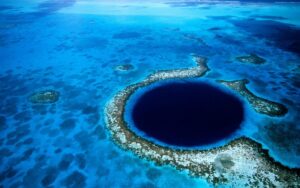
(Flickr/tofoli.douglas)
Located off the coast of Belize, the Great Blue Hole is a massive underwater sinkhole measuring over 300 meters (984 feet) across and 124 meters (407 feet) deep. Formed during past ice ages, it began as a limestone cave system that collapsed under rising sea levels, creating its distinctive circular shape.
Renowned for its deep blue color and rich biodiversity, the Great Blue Hole attracts divers from around the world. Its crystal-clear waters offer glimpses of Caribbean reef sharks, colorful fish, and intricate formations like submerged stalactites and stalagmites. Divers explore its steep walls and diverse marine life in an unforgettable underwater adventure.
As part of the Belize Barrier Reef Reserve System, a UNESCO World Heritage site, conservation efforts focus on sustainable tourism practices. Visitors can explore nearby islands and marine reserves while contributing to the preservation of this natural wonder and its fragile ecosystem.
8. Giant’s Causeway, Northern Ireland

(en.wikipedia.org)
The Giant’s Causeway, a UNESCO World Heritage site on Northern Ireland’s coast, is renowned for its stunning hexagonal basalt columns, resembling a pathway into the sea. Formed approximately 50-60 million years ago by volcanic activity, it remains a marvel of natural beauty and scientific interest.
These unique columns were created as molten basalt cooled rapidly upon contact with water, resulting in interlocking hexagonal shapes of varying heights and diameters. The landscape extends dramatically into the Atlantic Ocean, creating a surreal and captivating sight.
Visitors can explore the Giant’s Causeway through guided tours and walking trails, learning about its formation and natural history at interactive visitor centers. The site’s coastal setting provides panoramic views and opportunities to appreciate its geological wonders up close.
9. Salar de Uyuni, Bolivia

(commons.wikipedia)
Salar de Uyuni, located in southwest Bolivia, is the world’s largest salt flat, spanning over 10,000 square kilometers (3,900 square miles) of dazzling white landscape. Formed from ancient lakes evaporating, it represents a stunning blend of geological history and natural beauty.
During the rainy season (typically December to April), a thin layer of water covers the salt crust, transforming Salar de Uyuni into a vast mirror that reflects the sky with remarkable clarity. This creates surreal and picturesque vistas, attracting photographers and travelers seeking its unique allure.
Salar de Uyuni remains a testament to Bolivia’s natural wonders, offering a glimpse into its geological past and vibrant cultural present. Its transformation into a natural mirror during the rainy season continues to inspire awe and fascination worldwide.
10. Amazon Rainforest, South America

(Flickr/CIFOR-ICRAF)
The Amazon Rainforest spans 5.5 million square kilometers (2.1 million square miles) across South America, making it the world’s largest tropical rainforest and a biodiversity treasure trove.
This vast expanse hosts unparalleled biodiversity, with millions of species of plants, animals, and insects. Iconic wildlife like jaguars, sloths, and vibrant bird species such as macaws and toucans thrive under its dense canopy.
The Amazon plays a crucial role in global climate regulation and carbon storage, serving as a vital buffer against climate change. Its intricate river systems, including the Amazon River, sustain diverse ecosystems and indigenous communities.
